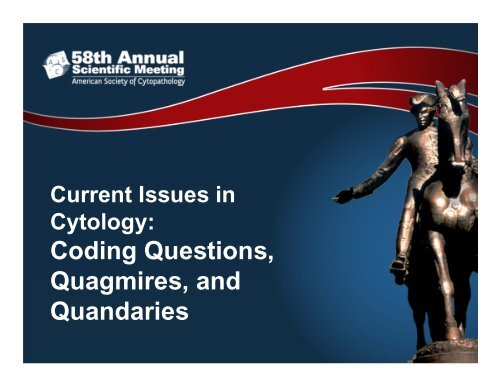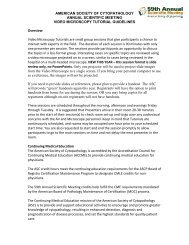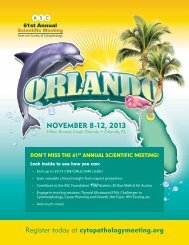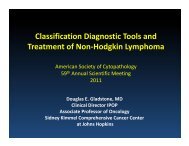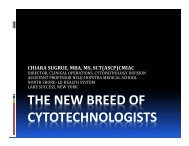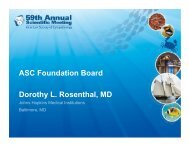Current Issues in Cytology Coding Questions, Quandaries and ...
Current Issues in Cytology Coding Questions, Quandaries and ...
Current Issues in Cytology Coding Questions, Quandaries and ...
Create successful ePaper yourself
Turn your PDF publications into a flip-book with our unique Google optimized e-Paper software.
<strong>Current</strong> <strong>Issues</strong> <strong>in</strong><strong>Cytology</strong>:Cod<strong>in</strong>g <strong>Questions</strong>,Quagmires, <strong>and</strong><strong>Qu<strong>and</strong>aries</strong>
Please turn off or silence your cell phones
PanelistsDiane Davis Davey, MD: University of CentralFlorida, Orl<strong>and</strong>o (Moderator)Susan E. Spires, MD: University of KentuckyW. Stephen Black‐Schaffer, MD: MassachusettsGeneral HospitalDennis Padget, MBA, CPA, FHFMA: DLPadgetEnterprises, Inc., FloridaCarol Ann Filomena, MD: Duke University,Durham
Schedule• Dr. Spires: CPT <strong>and</strong> RUC process• Dr. Black‐Schaffer: Regulatory background• Break• Mr. Padget: Practical applications <strong>in</strong>clud<strong>in</strong>gnew cytology codes• Dr. Filomena: Role as CPT Advisor for ASC• Panel <strong>and</strong> audience questions
Panel Objectives• Describe the genesis of CPT codes <strong>and</strong> howthey are valued for payment• Correctly document <strong>and</strong> code cytologyimmediate evaluation procedures• List new cytology CPT codes <strong>and</strong> describe howthey are used• Identify <strong>and</strong> correct frequent cod<strong>in</strong>g errors <strong>in</strong>the cytology laboratory
CODING QUESTIONS,QUAGMIRES ANDQUANDARIESSUSAN E. SPIRES MDUniversity of Kentucky College of Medic<strong>in</strong>e
Conflict of <strong>in</strong>terest•No conflicts of <strong>in</strong>terest•CAP Delegate RUC 2008to present•ASC RUC Advisor, 1999 to2008
HOW DO WE GET PAID?• Fee for Service based on CPT codes <strong>and</strong>Negotiated Amounts for the service...• Third parties—negotiated <strong>in</strong>dividually• Governmental—negotiated nationallywith code <strong>and</strong> fee development througha rule mak<strong>in</strong>g process
The Players <strong>and</strong> the Process• AMA Specialty Society CPT Committee• The AMA/ Specialty Society RBRVSUpdate Committee (RUC)• CMS <strong>and</strong> Development of the F<strong>in</strong>al RuleImportant because 3 rd party payers closelyfollow Government payment rules
Overview of the “language” of medical bill<strong>in</strong>g:CPT codes.CPT is the universal “language” used today <strong>in</strong> theUnited States to describe, bill, <strong>and</strong> pay medical,surgical, <strong>and</strong> related physician services <strong>and</strong>procedures. (DME or goods excluded).CPT taxonomy offers HCPs, hospitals, laboratories,third‐party payers, managed care companies, <strong>and</strong>private medical <strong>in</strong>surers a way to communicateconsistently <strong>and</strong> concisely regard<strong>in</strong>g the medical<strong>and</strong> surgical services they provideCPT is a registered trademark of the American MedicalAssociation (AMA), <strong>and</strong> the text is owned <strong>and</strong>ma<strong>in</strong>ta<strong>in</strong>ed exclusively by the AMA.
CPT—<strong>Current</strong> ProceduralTerm<strong>in</strong>ology• The current cod<strong>in</strong>g system is based on 5‐digits/characters.• Category I– 00000‐01999 Anesthesiology– 10000‐69999 Surgery– 70000‐79999 Radiology– 80000‐89999 Laboratory <strong>and</strong> Pathology– 90000‐99999 Medic<strong>in</strong>e(99201‐99445 Evaluation & Management)• Category II (Performance measures‐‐PQRI)– 0001F‐6999F• Category III (New technology)0001T‐XXXT
Procedures listed <strong>in</strong> CPT areclassified by category• Category I services are those that reflect thecontemporary, widespread practice ofmedic<strong>in</strong>e by physicians <strong>in</strong> this country.• 99% of all procedural entries <strong>in</strong> CPT fall underthis category.• Category I is updated effective each January 1through the CPT‐RUC cycle.
Use CPT for All Payers <strong>and</strong> Insurers.• In 2000, DHHS selected CPT as the nationalst<strong>and</strong>ard for report<strong>in</strong>g medical services underthe Health Insurance Portability <strong>and</strong>Accountability Act• Accord<strong>in</strong>g to HIPAA, the CPT data set must beused by all providers, government payers,<strong>and</strong> private medical <strong>in</strong>surers.
CPT CODE PROCESS• CPT Editorial Panel• 16 members‐<strong>in</strong>clud<strong>in</strong>g Internal Medic<strong>in</strong>e,Family Practice, Surgery, Pathology, CMS,Managed Care, Insurance Industry.• CPT Advisory Committee• >90 members from all specialty societiesrepresented <strong>in</strong> AMA Federation + several otherphysician/non‐physician societies (<strong>in</strong>clud<strong>in</strong>gUSCAP, ASC, ASCP, ACMG, AACC).• Responsible for code language, development <strong>and</strong>presentation of codes at CPT
CPT Advisory CommitteeThe CPT advisor for ASC:Carol Filomena, MDcarol.filomena@duke.edu
CPT Codes-the Basis ofPayment• Category I CPT Code changes: Any professional ororganization has the ability to request a codeaddition, deletion, or modification.• Code proposals as submitted by <strong>in</strong>dividuals, <strong>in</strong>dustryor SS are screened through the CPT advisors (<strong>and</strong>PCC), then presented to the Editorial Panel fordecision.• It is a political process!• It is a slow process!• It is an arcane process!
For Laboratory CPT codes• Pathology Cod<strong>in</strong>g Caucus- Created 2003by the AMA Editorial Panel, partially <strong>in</strong>response to HIPAA <strong>and</strong> the concerns ofthe non-physician laboratory communityfor a voice <strong>in</strong> laboratory CPT cod<strong>in</strong>g• Role: Through a consensus process,communicate a unified op<strong>in</strong>ion on Lab <strong>and</strong>Pathology codes to CPT• Chaired <strong>and</strong> staffed by the College ofAmerican Pathologists
CPT ACTIONSA CPT code request may be:• Accepted as submitted• Accepted with modification– which may occur up to the date of release of thelevel of <strong>in</strong>terest forms to the RUC advisors• Rejected to be modified <strong>and</strong> resubmitted
CPT Codes-the Basis ofPayment• AMA‐CPT ma<strong>in</strong>ta<strong>in</strong>s the codes <strong>and</strong> doesNOT set the prices.• The Resource Based Relative ValueSystem Update Committee or• RUC allocates payment <strong>in</strong> RVUs
RUC PROCESS:Which codes are RUC valued?: Which codes are RUC valued?• “Physician” performed test<strong>in</strong>g ResourceBased Relative Value System (RB‐RVS)• Cl<strong>in</strong>ical laboratory analyses performed bynon physicians Cl<strong>in</strong>ical Laboratory FeeSchedule (CLFS) with statutorily determ<strong>in</strong>edpayment. Includes Pap screen<strong>in</strong>g.
CPT/RUC Cycle for develop<strong>in</strong>gcodes <strong>and</strong> Payment• CPT meets 3 times a year to determ<strong>in</strong>e codechanges for the next year• RUC meets 3 times a year to consider <strong>and</strong> toprovide recommendations for $• CMS publishes the annual update to the MedicareRVS <strong>in</strong> the Federal Register• Codes <strong>and</strong> values go <strong>in</strong>to effect annually January 1• Strictly confidential with prohibition ofdiscussion of codes until PFS published <strong>in</strong> theF<strong>in</strong>al Rule
CPT- RUC CycleCodeCPT EditorialPanelMedicarePaymentScheduleLevel of InterestSurveyCMSThe RUCSpecialtySociety RVSCommittee
Medicare RBRVS• St<strong>and</strong>ardized physician payment schedulewhere payments for services are determ<strong>in</strong>edby the survey‐derived relative work <strong>and</strong> coststo provide them• Most public <strong>and</strong> private payors utilize someform of Medicare RBRVS scale• While third party payers are bound by HIPAAto use CPT they are not required to use theMC PFS amount
RUC CompositionAmerican Medical AssociationAnesthesiologyCardiologyDermatologyEmergency Medic<strong>in</strong>eFamily Medic<strong>in</strong>eGastroenterology*General SurgeryPulmonaryMedic<strong>in</strong>e** <strong>in</strong>dicates rotat<strong>in</strong>g seatInternal Medic<strong>in</strong>eNeurologyNeurosurgeryObstetrics/GynecologyOphthalmologyOrthopaedicSurgeryOtolaryngologyPathologyColorectal Surgery*PediatricsPlastic SurgeryPsychiatryRadiologyThoracic SurgeryUrology
RUC Advisory Committee• One physician representative appo<strong>in</strong>ted fromeach of the 109 specialty societies seated <strong>in</strong> theAMA House of Delegates• Advisory Committee members assist <strong>in</strong> thedevelopment of Valuation <strong>and</strong> present theirspecialties’ recommendations to the RUC• Each member is allowed comment onrecommendations made by other specialties
RUC Advisory CommitteeThe ASC RUC advisor:Margaret Havens Neal MDamhneal@yahoo.com
AMA Relative Value UpdateCommittee (RUC)• Pathology at the table with 25 otherspecialties• Set new/revised code values relative to otherservices• Public (government) ‐ private (physicians)partnership <strong>in</strong>stead of government dictatedpayment amounts
One view of Reimbursement
RUC Survey ProcessSelection of Reference Codes• Allows for comparison physician work of newor revised code to the work of an establishedcode• Survey participants are given a specificreference list <strong>and</strong> must choose a code they arefamiliar with which is similar to the new orrevised code
Physician Work Survey• Relative value units (“RVUs”)• Determ<strong>in</strong>ed by:– Time to perform the service– Technical skill <strong>and</strong> physical effort– Mental effort <strong>and</strong> judgment– Stress due to potential risk to the patient
RUC Survey <strong>Issues</strong>
Practice Expense• Initially, allocated as % MD work (“HarvardStudies was 40%)• In 1999, CMS transitioned to a resource‐basedpractice expense relative value for each CPTcode• Direct expenses: eg scalpel blades, reagents,slides• Indirect: eg secretarial, computer, rent
Components of 88305-26
Calculat<strong>in</strong>g PaymentThe general formula for calculat<strong>in</strong>g Medicare paymentamounts for Jan 1 – December 31, 2010,is derived by multiply<strong>in</strong>g each component as adjusted bygeographic practice cost <strong>in</strong>dex:– Total RVU =– [(wRVU x wGPCI) + (peRVU x peGPCI)– + (pliRVU x pliGPCI)]– Total RVU x Conversion Factor* = Medicare Payment*The Conversion Factor for CY 2010 = $36.87 (For 2009 was $36.0666)
CPT 1993 - 2009 RUCRecommendations• CMS/Carrier MedicalDirector review• Proposed Rule <strong>in</strong> June witha 60‐day Comment period• F<strong>in</strong>al Rule <strong>in</strong> November• CMS’s acceptance rate ofRUC proposals wastraditionally more than90% annually until now.
CMS RULES AND REGS• Payment determ<strong>in</strong>ation doesn’t stop at theF<strong>in</strong>al Rule Stage• There is an suprastructure of caveats <strong>and</strong>limitations to payment– NCCI– MUEs• Many apply to some 3 rd party payers
CMS RULES AND REGS• Medicare does not pay for services that are notreasonable <strong>and</strong> medically necessary– Title 18 SSA, Sec 1862: No payment may be made underPart A or B for any expenses <strong>in</strong>curred…which are notreasonable <strong>and</strong> necessary for the diagnosis or treatmentof illness or <strong>in</strong>jury or to improve the function<strong>in</strong>g of amalformed member.– Exception: Statutorily def<strong>in</strong>ed screen<strong>in</strong>g tests• Documentation of services provided isM<strong>and</strong>atory‐ Legible, ma<strong>in</strong>ta<strong>in</strong>ed <strong>in</strong> Medical record<strong>and</strong> signed by physician or HCP, eg. IE on FNA
CMS RULES ANDREGULATIONS• Medicare does not pay for QualityAssurance!!!e.g. Paps to Pathologist where no suspectedabnormality is present• Unbundl<strong>in</strong>g is prohibited…“CMS does not pay twice …for the same testresult even if performed by two methodsunless…medically reasonable <strong>and</strong> necessary.” e.g.BAL w/ cytosp<strong>in</strong>s <strong>and</strong> th<strong>in</strong>prep, may bill either 88108 or88112• Therefore…
CMS RULES ANDREGULATIONS• With multiple services on one beneficiary, sameprovider, same day [e.g. ur<strong>in</strong>e cytosp<strong>in</strong>s (88108),sputum smears (88161)], add ‐59 Modifier(bypass<strong>in</strong>g edits)• Reflex test<strong>in</strong>g is allowable (somewhat):Some tests require additional test<strong>in</strong>g e.g. abnormalPap requires MD <strong>in</strong>terpretation with st<strong>and</strong><strong>in</strong>gorderOtherwise physician order is required, e.g. HPVtest<strong>in</strong>g on ASCUS Pap
• CPT determ<strong>in</strong>es payment amount• ICD‐9 required to document necessity** PM 6‐10‐03, ..rem<strong>in</strong>der that physicians/ practitioners “mustprovide a diagnosis on all orders <strong>and</strong> referrals” not merelylab tests or screen<strong>in</strong>g cytology. Must be provided by thepractitioner, not derived from archives.
• ICD‐9 Codes (Diagnosis Codes)– M<strong>and</strong>atory for all, CPT code specific for lab <strong>and</strong>screen<strong>in</strong>g benefit payment– Updated semi‐annually <strong>in</strong> April & October with nograce period• Made up of 3, 4 or 5 digits• Coded to highest level of specificity
Acceptable Screen<strong>in</strong>g PapDiagnoses• V72.31 –rout<strong>in</strong>e Physical exam• V72.32 –Physical exam, high risk• V76.2 –rout<strong>in</strong>e Pelvic exam• V76.47 –post hysterectomy fornon‐malignant condition• V76.49 –patients without cervix• V15.89 –rout<strong>in</strong>e pelvic, high risk• Signs <strong>and</strong> symptoms• Covers Pap payment at 11 or 23 month <strong>in</strong>tervalsRout<strong>in</strong>e/ScreenCodes
Diagnostic ICD-9’s (not “V” codes)for medical necessity• 795.0 series: excludes CIN, SIL, CIS on biopsy795.00: AGUS 795.01: ASCUS795.02: ASC‐H 795.03: LGSIL795.04: HGSIL 795.05: HR‐DNA +795.07: Sat Pap lack<strong>in</strong>g TZ795.08: Unsat Pap 795.09: Other abnl smear/HPV795.10‐.19: Vag<strong>in</strong>al Pap abnormalities
ASC Membership Role <strong>in</strong> PaymentProcess• Be a tireless advocate for the practice of<strong>Cytology</strong>, not just <strong>in</strong> DC but <strong>in</strong> everydaypractice• Present a unified voice through the ASC <strong>and</strong>CAP (among others)• Stay vigilant <strong>and</strong> <strong>in</strong>form your leadership <strong>and</strong>advisors of payment issues requir<strong>in</strong>g address
Keep it up!When you th<strong>in</strong>k you’ref<strong>in</strong>ished, you are f<strong>in</strong>ished!‐‐‐ Benjam<strong>in</strong> Frankl<strong>in</strong>
<strong>Current</strong> <strong>Issues</strong> <strong>in</strong> <strong>Cytology</strong>:Cod<strong>in</strong>g <strong>Questions</strong>,<strong>Qu<strong>and</strong>aries</strong> <strong>and</strong> QuagmiresStephen Black-Schaffer, M.D.Massachusetts General HospitalNovember 15, 2010
Conflict of <strong>in</strong>terestNone
The bolts <strong>and</strong> nuts of paymentpolicy…• I know this is backwards.• Backwards is a good way to th<strong>in</strong>k about this!• Why?• The Golden Rule (à la Mark Synovec):• "They have the gold; they make the rules."• So ask yourself, "What Would Payers Do?"• You'll have a better chance of underst<strong>and</strong><strong>in</strong>ghow (<strong>and</strong> why) this all works the way it does.
PATIENT(INSURANCE)SERVICE(CPT)PAYMENTCONDITION(ICD)PROVIDER(CREDENTIALS)
Edits <strong>and</strong> audits• Payers have two ways to apply their rules:• Prepayment edits• Postpayment audits• CMS has the most comprehensive publiclyavailable set of payment policies• So that's what compliance programs target
Major Risk AreasReasonable <strong>and</strong> Necessary ServicesMedically Unlikely Services
Unit cod<strong>in</strong>g – what is it?• It's how we code for our services <strong>in</strong> anatomicpathology– (exception = flow cytometry)• Each <strong>and</strong> every separate item (sta<strong>in</strong>) or service(specimen) gets a code• A pathology bills looks like a laundry list!Is this good or bad?
Unit cod<strong>in</strong>g – pros <strong>and</strong> cons• Pros - pathology is dist<strong>in</strong>ctive:• Accurate work representation• Addition new technologies• Adoption new practices• Cons - pathology is dist<strong>in</strong>ctive:• Multiple different codes to report episode of careNational Correct Cod<strong>in</strong>g Initiative (NCCI)• Multiples of same code to report episode of careMedically Unlikely Unbelievable Edits Edits (MUEs) (MUEs)
What are MUEs?• The MUE for a CPT code is the maximum units ofservice under most circumstances that a providerwould report for that code for a s<strong>in</strong>gle beneficiary ona s<strong>in</strong>gle date of service.• Medicare contractors adjudicate each l<strong>in</strong>e of a claimseparately aga<strong>in</strong>st the MUE value for the code onthat l<strong>in</strong>e.• The appropriate use of some modifiers (e.g., ‐59)may bypass an MUE value because the modifiercauses the CPT code to appear on separate l<strong>in</strong>es ofthe claim.
What is the "modifier" option?• Modifier ‐59: Dist<strong>in</strong>ct Procedural Service: <strong>in</strong>dicate aprocedure or service was dist<strong>in</strong>ct or <strong>in</strong>dependentfrom other services performed on the same day.• This may represent a different session or patientencounter, different procedure or surgery, differentsite or organ system, separate <strong>in</strong>cision/excision, orseparate lesion.2. Be cautious about report<strong>in</strong>g services on multiplel<strong>in</strong>es of a claim utiliz<strong>in</strong>g modifiers to bypass MUEs.
NCCI/MUE Policy Manual for MedicareServices, Version 16.3 - EffectiveOctober 1, 20106. The unit of service for CPT code 88172 is theseparately identifiable lesion (tumor).• Per the code descriptor all specimens from a s<strong>in</strong>glelesion are <strong>in</strong>cluded <strong>in</strong> a s<strong>in</strong>gle unit of service.• Multiple "passes" <strong>in</strong>to the same lesion to obta<strong>in</strong>multiple specimens for immediate cytohistologicstudy, are <strong>in</strong>cluded <strong>in</strong> the s<strong>in</strong>gle unit of service.
NCCI/MUE Policy Manual for MedicareServices, Version 16.3 - EffectiveOctober 1, 2010• The same concept applies to the unit of service forCPT code 88173 (cytopathology, evaluation of f<strong>in</strong>e needleaspirate; <strong>in</strong>terpretation <strong>and</strong> report).• A separate unit of service may be reported for eachdist<strong>in</strong>ct, separate lesion, but only one unit of servicemay be reported for all specimens from a s<strong>in</strong>glelesion.
How to f<strong>in</strong>d the MUEs• The majority of MUEs are posted on the CMSwebsite accessed through the MUE webpage athttp://www.cms.hhs.gov/NationalCorrectCodInitEd/08_MUE.asp#TopOfPage• Published MUE consist of most codes with MUEvalues of 1‐3. CMS does not publish all MUE valuesof 4 or higher because of concerns about fraud <strong>and</strong>abuse.• CMS updates MUE values <strong>and</strong> NCCI edits quarterly.
Published anatomic pathologyMUEs11883314 88104, 88160, 88161, 88311, 88329, 88333, 883473 88106, 88162, 88172, 88173, 88233, 88239, 88240, 88241,88273, 88309, 883182 88182, 88230, 88261, 88262, 88264, 88267, 88269, 88283,88300, 88302, 883581 88125, 88130, 88140, 88141, 88142, 88143, 88147, 88148,88150, 88152, 88153, 88154, 88155, 88164, 88165, 88166,88167, 88174, 88175, 88184, 88187, 88188, 88189, 88245,88248, 88249, 88263, 88289, 88291, 88321, 88323, 88325,88348, 88349, 88355, 88356, 88362, 88371, 88372, 88380,88381, 88384, 88385, 88386
Major Risk AreasReasonable <strong>and</strong> Necessary ServicesNational Correct Cod<strong>in</strong>g Initiative
Pros <strong>and</strong> cons of unit cod<strong>in</strong>g• Pros - pathology is dist<strong>in</strong>ctive:• Accurate work representation• Addition new technologies• Adoption new practices• Cons - pathology is dist<strong>in</strong>ctive:• Multiple different codes to report episode of careNational Correct Cod<strong>in</strong>g Initiative (NCCI)• Multiples of same code to report episode of careMedically Unlikely Unbelievable Edits Edits (MUEs) (MUEs)
National Correct Cod<strong>in</strong>gInitiative (NCCI)• NCCI => "edit pairs" of CPT codes => not considered(by CMS) separately payable when => services billed:• => by same provider• => for same patient• => on same day.
NCCI edits with flow cytometry(selected)
National Correct Cod<strong>in</strong>gInitiative (NCCI)The … edits have column 1 code of [flow cytometry]. The column 2codes are cytopathology codes that are often misused with [flowcytometry].Some providers report one of these [cytopathology] codes whenthey … perform… flow cytometry <strong>and</strong> <strong>in</strong>terpret… othercytopathology … material.In this category, the column 2 coded procedures are both part ofthe flow cytometry procedure <strong>and</strong> duplicative of the otherdiagnostic material.These edits permit use of NCCI associated modifiers if the column 2coded cytopathology procedures are performed for diagnosticpurposes unrelated to the flow cytometry test<strong>in</strong>g process <strong>and</strong> arenot duplicative of the other diagnostic cytological … material.
NCCI edits with flow cytometry(selected)
NCCI/MUE Policy Manual for MedicareServices, Version 16.3 - EffectiveOctober 1, 2010• 3. Medicare does not pay for duplicate test<strong>in</strong>g.• immunocytochemistry <strong>and</strong> flow cytometry shouldnot <strong>in</strong> general be reported for the same or similarspecimens.• The diagnosis should be established us<strong>in</strong>g one ofthese methods.• report both CPT codes if both methods are requiredbecause the <strong>in</strong>itial method does not expla<strong>in</strong> all thelight microscopic f<strong>in</strong>d<strong>in</strong>gs.• report both methods utiliz<strong>in</strong>g modifier ‐59 <strong>and</strong>document the need for both methods <strong>in</strong> the medicalrecord
Major Risk AreasReasonable <strong>and</strong> Necessary ServicesLocal Coverage Determ<strong>in</strong>ations
Local CoverageDeterm<strong>in</strong>ations (LCDs)• Local coverage determ<strong>in</strong>ations (LCDs) => more than90% of all Medicare coverage decisions.• The Social Security Act authorizes CMS to pay forreasonable <strong>and</strong> medically necessary services.• "Reasonable <strong>and</strong> necessary" is language that allowsCMS <strong>and</strong> its Medicare Adm<strong>in</strong>istrative Contractors(MACs) to deny claims for services they do notconsider medically necessary.• An LCD limits payment for a CPT‐service your MACconsiders to be subject to medically <strong>in</strong>appropriateutilization.
MAC Jurisdictions <strong>in</strong> 2010
MAC Jurisdictions <strong>in</strong> 2016
DHHS OIG Risk Areas• Risk Area: A. Local Coverage Determ<strong>in</strong>ation• Physicians must bill Federal health careprograms• => only for reasonable <strong>and</strong> necessary items <strong>and</strong>services.• Physician must apply appropriate LCD• => whether item or service is reasonable <strong>and</strong>necessary under Medicare guidel<strong>in</strong>es.• https://www.cms.gov/mcd/overview.asp
LCD forimmunohistochemistry (L29813)• 42 CFR, Section 410.32, <strong>in</strong>dicates that diagnostictests may only be ordered by the treat<strong>in</strong>g physician.• A pathologist may perform additional tests under thefollow<strong>in</strong>g circumstances:• These services are medically necessary so that acomplete <strong>and</strong> accurate diagnosis can be reported to thetreat<strong>in</strong>g physician;• The results of the tests are communicated to <strong>and</strong> areused by the treat<strong>in</strong>g physician <strong>in</strong> the treatment of thebeneficiary; <strong>and</strong>• The pathologist documents <strong>in</strong> his/her report whyadditional test<strong>in</strong>g was done.
LCD forimmunohistochemistry (L29813)• Documentation Requirements• The patient's medical record must conta<strong>in</strong>documentation that fully supports the medical necessityfor services <strong>in</strong>cluded with<strong>in</strong> this LCD.• This documentation <strong>in</strong>cludes, but is not limited to,relevant medical history, physical exam<strong>in</strong>ation, <strong>and</strong>results of pert<strong>in</strong>ent diagnostic tests or procedures.
LCD forimmunohistochemistry (L29813)• Indications:Immunohistochemistry is useful <strong>in</strong> the evaluation ofvarious malignancies, for diagnosis, stag<strong>in</strong>g, <strong>and</strong> theestimation of prognosis. It is also useful for theidentification of a number of <strong>in</strong>fectious organisms.• Utilization Guidel<strong>in</strong>es:It is unusual to require more than 10immunohistochemical analyses <strong>in</strong> order to adequatelyevaluate a sample of tissue. Utilization beyond thisthreshold should be supported <strong>in</strong> the medical record, <strong>and</strong>may be subject to review.
Local CoverageDeterm<strong>in</strong>ations (LCDs)• The most important section of an LCD is the list ofcovered diagnoses.• ICD codes are used to list covered diagnoses, signs orsymptoms => any diagnosis, sign or symptom not onthis list is typically not covered.
LCD forimmunohistochemistry (L29813)• Limitations of Coverage:• ICD Codes that Support Medical Necessity• The correct use of an ICD code does not assure coverageof a service.• The service must be reasonable <strong>and</strong> necessary <strong>in</strong> thespecific case <strong>and</strong> must meet the criteria specified <strong>in</strong> thisdeterm<strong>in</strong>ation.
Listed ICDs for immunohistochemistry (L29813)041.86 HELICOBACTER PYLORI070 - 070.9 VIRAL HEPATITIS078.1 VIRAL WARTS UNSPECIFIED078.11 CONDYLOMA ACUMINATUM078.19 OTHER SPECIFIED VIRAL WARTS079.4 HUMAN PAPILLOMAVIRUS079.83 PARVOVIRUSB19079.89 OTHER SPECIFIED VIRAL INFECTION079.98 UNSPECIFIED CHLAMYDIAL INFECTION079.99 UNSPECIFIED VIRAL INFECTION140 - 208.92 MALIGNANT NEOPLASM210 - 229.9 BENIGN NEOPLASM230 - 234.9 CARCINOMA IN SITU235 - 239.9 NEOPLASM OF UNCERTAIN BEHAVIOR273.1 MONOCLONAL PARAPROTEINEMIA289.1 CHRONIC LYMPHADENITIS289.2 NONSPECIFIC MESENTERIC LYMPHADENITIS289.3 LYMPHADENITIS UNSPECIFIED EXCEPT MESENTERIC348.89 OTHER CONDITIONS OF BRAIN359 - 359.9 MYOPATHY511.9 UNSPECIFIED PLEURAL EFFUSION530.0 - 578.9 HEMORRHAGE OF GASTROINTESTINAL TRACT579 CELIAC DISEASE
Listed ICDs for immunohistochemistry (L29813)596.8 OTHER SPECIFIED DISORDERS OF BLADDER596.9 UNSPECIFIED DISORDER OF BLADDER600 - 602.9 DISORDERS OF PROSTATE610.0 - 610.9 SOLITARY CYST OF BREAST - BENIGN MAMMARY DYSPLASIA UNSPECIFIED611.0 - 611.9 INFLAMMATORY DISEASE OF BREAST - UNSPECIFIED BREAST DISORDER728.2 MUSCULAR WASTING AND DISUSE ATROPHY NOT ELSEWHERE CLASSIFIED728.87 MUSCLE WEAKNESS (GENERALIZED)733.13 PATHOLOGICAL FRACTURE OF VERTEBRAE733.99 OTHER DISORDERS OF BONE AND CARTILAGE782.2 LOCALIZED SUPERFICIAL SWELLING MASS OR LUMP782.4 JAUNDICE UNSPECIFIED NOT OF NEWBORN782.8 CHANGES IN SKIN TEXTURE784.2 SWELLING MASS OR LUMP IN HEAD AND NECK785.6 ENLARGEMENT OF LYMPH NODES786.6 SWELLING MASS OR LUMP IN CHEST787.20 - 787.7 DYSPHAGIA, UNSPECIFIED - ABNORMAL FECES789.00 - 789.9 SYMPTOMS INVOLVING ABDOMEN AND PELVIS790.93 ELEVATED PROSTATE SPECIFIC ANTIGEN [PSA]791.9 OTHER NONSPECIFIC FINDINGS ON EXAMINATION OF URINE795.05 CERVICAL HIGH RISK HUMAN PAPILLOMAVIRUS (HPV) DNA TEST POSITIVE795.09 OTHER ABNORMAL PAPANICOLAOU SMEAR OF CERVIX AND CERVICAL HPV795.4 OTHER NONSPECIFIC ABNORMAL HISTOLOGICAL FINDINGS996.80 - 996.89 COMPLICATIONS OF TRANSPLANTED ORGAN
What's miss<strong>in</strong>g here?This is such a long list … what could it be miss<strong>in</strong>g?Sounds like a job for … the CAC rep!Who's that?
Local CoverageDeterm<strong>in</strong>ations (LCDs)• Congress created the Contractor Advisory Committee(CAC) as the advisory body for Medicare contractors.• The CAC is composed of physicians from listedspecialties (pathology <strong>in</strong>cluded) as well as frommedical societies <strong>and</strong> other relevant entities.• The CAC representative is a liaison represent<strong>in</strong>gop<strong>in</strong>ions of his or her specialty <strong>and</strong> provid<strong>in</strong>g adviceto Medicare contractors <strong>in</strong> the development of LCDs.• When diagnosis code set is established, the ICDcodes are <strong>in</strong>corporated <strong>in</strong>to the Medicarecontractor's claims‐process<strong>in</strong>g software.
Local CoverageDeterm<strong>in</strong>ations (LCDs)• Claims for a service covered by an LCD submittedwithout a listed ICD code will be denied.• Medicare rules allow Contractor Medical Directors(CMDs) to add ICD diagnoses to the diagnosis codeset without requir<strong>in</strong>g comment.• Br<strong>in</strong>g<strong>in</strong>g forward omitted ICD codes for an LCD is atypical responsibility for a CAC member.• So, to deal with an LCD problem, you need to knowyour MAC, your CAC … <strong>and</strong> also your ICDs!
ICD cod<strong>in</strong>g concepts• What is the basic concept of ICD cod<strong>in</strong>gfor diagnostic services?• Pathologists – code your own diagnosis• Cytotechnologists – code the <strong>in</strong>dication• Screen<strong>in</strong>g services – code for screen<strong>in</strong>g
DHHS & CMS Transmittal B-01-61• A. Diagnostic Tests Ordered for Signs <strong>and</strong>/or Symptoms1. If a diagnosis is made by the pathologist on a test:• code the pathologist's diagnosis;• cl<strong>in</strong>ical signs <strong>and</strong> symptoms may also be coded=> unless fully expla<strong>in</strong>ed by pathologist's diagnosis– Example: Surgical specimen sent to pathologist with cl<strong>in</strong>icaldiagnosis of "mole." Pathologist personally reviews slides madefrom specimen <strong>and</strong> makes diagnosis of "malignant melanoma."Pathologist should code "malignant melanoma" as primarydiagnosis.
DHHS & CMS Transmittal B-01-612. If no diagnosis is made on the test:• code the reason (signs <strong>and</strong> symptoms) for the test– Example 1: Patient referred to radiologist for sp<strong>in</strong>e x‐ray withcompla<strong>in</strong>t of "back pa<strong>in</strong>." Radiologist performs x‐ray <strong>and</strong> resultsare normal. Radiologist should code diagnosis of "back pa<strong>in</strong>" s<strong>in</strong>cethis was reason for perform<strong>in</strong>g sp<strong>in</strong>e x‐ray.– Example 2: Patient seen <strong>in</strong> ER for chest pa<strong>in</strong>. EKG normal, <strong>and</strong> f<strong>in</strong>aldiagnosis chest pa<strong>in</strong> due to suspected gastroesophageal refluxdisease (GERD). Patient told to follow‐up with primary carephysician for further evaluation of suspected GERD. Primarydiagnosis code for EKG should be chest pa<strong>in</strong>. (Though EKG normal,def<strong>in</strong>itive cause for chest pa<strong>in</strong> not determ<strong>in</strong>ed.)
DHHS & CMS Transmittal B-01-613. If no diagnosis made on the test,<strong>and</strong>• The referr<strong>in</strong>g physician's reason for the test is a diagnosis that<strong>in</strong>dicates uncerta<strong>in</strong>ty (e.g., probable, suspected, questionable,rule out, or work<strong>in</strong>g):=> do not code the referr<strong>in</strong>g physician's (uncerta<strong>in</strong>) diagnosticreason for the test;=> code the patient's signs <strong>and</strong> symptoms• Example: Patient referred to radiologist for chest x‐ray, with cl<strong>in</strong>ical diagnosis"rule out pneumonia." Radiologist performs chest x‐ray, <strong>and</strong> results are normal.Radiologist should code sign(s) or symptom(s) that prompted test (e.g., cough).
DHHS & CMS Transmittal B-01-61• B. Determ<strong>in</strong><strong>in</strong>g the Reason for the Test• All tests must be ordered by the treat<strong>in</strong>g physician=> the treat<strong>in</strong>g physician must provide diagnostic <strong>in</strong>formation(reason) when the test is ordered• If no diagnosis made based on the test,<strong>and</strong> the referr<strong>in</strong>g physician is unavailable,=> obta<strong>in</strong> <strong>in</strong>formation from medical record,=> or directly from patient(but attempt to confirm patient <strong>in</strong>formation).
DHHS & CMS Transmittal B-01-61• E. Diagnostic Tests Ordered <strong>in</strong> Absence of Signs<strong>and</strong>/or Symptoms (e.g., screen<strong>in</strong>g tests)• Diagnostic tests ordered <strong>in</strong> the absence of signs,symptoms, or other evidence of illness or <strong>in</strong>jury,=> code screen<strong>in</strong>g as the primary diagnosis• Test result may be coded as additional diagnosis
DHHS & CMS Transmittal B-01-61• F. Use of ICD To Greatest Degree of Accuracy <strong>and</strong>Completeness• Code the diagnosis from test or the signs <strong>and</strong>symptoms to the highest degree of accuracy <strong>and</strong>completeness• "Highest degree of accuracy <strong>and</strong> completeness"means the precise code that most fully expla<strong>in</strong>s thenarrative description of sign, symptom, or diagnosis
Summary• To underst<strong>and</strong> payment policy, try to see it from thepayer's perspective, because they've got the gold, sothey make the rules!• MUEs are about multiple CPTs, <strong>and</strong> NCCI edits areabout CPT comb<strong>in</strong>ations => if you know the rules,you will know when you can override them• LCDs are about medical necessity, so these <strong>in</strong>volveboth services (CPTs) <strong>and</strong> diagnoses/signs/symptoms(ICDs) => if you know the rules, you will know how tocomply with them, <strong>and</strong> what to do to change them,when they don't work for you
Thank you!• <strong>Questions</strong>?
BREAK
Part II
Cytopathology CPT Cod<strong>in</strong>g<strong>Issues</strong> & SolutionsDennis L. Padget, MBA, CPA, FHFMADLPadget Enterprises, Inc. (The Villages, FL)
Conflict of <strong>in</strong>terestNo conflicts of <strong>in</strong>terest
2011 <strong>Cytology</strong> CPT ChangesNew 88120 –Cytopathology, <strong>in</strong> situ hybridization (eg,FISH), ur<strong>in</strong>ary tract specimen with morphometricanalysis, 3‐5 molecular probes, each specimen;manualNew 88121 –…; us<strong>in</strong>g computer‐assisted technologyNew (For morphometric <strong>in</strong> situ hybridization oncytologic specimens other than ur<strong>in</strong>ary tract, see88367, 88368)New (For more than 5 probes, use 88399)
2011 <strong>Cytology</strong> CPT ChangesChange 88172 –Cytopathology, evaluation of f<strong>in</strong>eneedle aspirate; immediate cytohistologic study todeterm<strong>in</strong>e adequacy for diagnosis, first evaluationepisode, each siteNew (The evaluation episode represents a complete set ofcytologic material submitted for evaluation <strong>and</strong> is<strong>in</strong>dependent of the number of needle passes or slidesprepared. A separate evaluation episode occurs if theproceduralist provider obta<strong>in</strong>s additional material from thesame site, based on the prior immediate adequacyassessment, or a separate lesion is aspirated)
2011 <strong>Cytology</strong> CPT ChangesNew (Report one unit of 88173 for the <strong>in</strong>terpretation<strong>and</strong> report from each anatomic site, regardless of thenumber of passes or evaluation episodes performeddur<strong>in</strong>g the aspiration procedure)Padget Note: The preced<strong>in</strong>g new parenthetical<strong>in</strong>struction appears immediately under listed code88173 [Cytopathology, evaluation of f<strong>in</strong>e needleaspirate;] <strong>in</strong>terpretation <strong>and</strong> report
2011 <strong>Cytology</strong> CPT ChangesNew + 88177 –…; immediate cytohistologic study todeterm<strong>in</strong>e adequacy for diagnosis, each separateadditional evaluation episode, same site (List separately<strong>in</strong> addition to code for primary procedure)New (When repeat immediate evaluation episode(s) isrequired on subsequent cytologic material from the same site,eg, follow<strong>in</strong>g determ<strong>in</strong>ation the prior sampl<strong>in</strong>g that was notadequate for diagnosis, use 1 unit of 88177 for eachadditional evaluation episode)New (Use 88177 <strong>in</strong> conjunction with 88172)
<strong>Cytology</strong> CPT Solutions• 88104 ‐ Cytopathology, fluids, wash<strong>in</strong>gs orbrush<strong>in</strong>gs, except cervical or vag<strong>in</strong>al; smearswith <strong>in</strong>terpretation• A “direct” smear is a swab or swipe‐type application ofcellular material to a glass slide. The smear is made withoutconcentrat<strong>in</strong>g or otherwise process<strong>in</strong>g the sample before it’stransferred to slides. The smear may be fixed or air‐dried.• The number of direct smear slides prepared for a specimendoesn’t affect the charge code: 88104 applies whether thenumber is one, six, twelve, etc.
<strong>Cytology</strong> CPT Solutions• 88106 ‐ Cytopathology, fluids, wash<strong>in</strong>gs or brush<strong>in</strong>gs,except cervical or vag<strong>in</strong>al; simple filter method with<strong>in</strong>terpretation• 88107 ‐ …; smears <strong>and</strong> simple filter preparation with<strong>in</strong>terpretation• Convention <strong>and</strong> logic direct that “simple filter method” refersto a millipore or nuclear membrane process• The millipore <strong>and</strong> nuclear membrane filter methods areseldom used <strong>in</strong> cytology labs today, so there’s a very goodchance you don’t need to concern yourself with [these]code[s].
<strong>Cytology</strong> CPT Solutions• 88108 ‐ Cytopathology, concentration technique,smears <strong>and</strong> <strong>in</strong>terpretation (eg, Saccomannotechnique)• Report this code when a fluid, wash<strong>in</strong>g, brush<strong>in</strong>g (<strong>in</strong>clud<strong>in</strong>g anendocervical brush<strong>in</strong>g), anal‐rectal cytology, or sputumsample is prepared by concentration method not <strong>in</strong>volv<strong>in</strong>gselective cellular enrichment or enhancement.• The most commonly encountered concentration methods…are cytosp<strong>in</strong>, Saccomanno, <strong>and</strong> general cytocentrifugation.• The number of concentrated smears prepared for a specimendoesn’t affect the charge code.
<strong>Cytology</strong> CPT Solutions• 88112 ‐ Cytopathology, selective cellularenhancement technique with <strong>in</strong>terpretation (eg,liquid‐based slide preparation method), exceptcervical or vag<strong>in</strong>al• Report 88112 when a fluid, wash<strong>in</strong>g, endocervical or otherbrush<strong>in</strong>g, or anal‐rectal cytology specimen is prepared byselective cellular enrichment or enhancement process,recogniz<strong>in</strong>g that concentration is <strong>in</strong>variably an <strong>in</strong>tegral part ofthat process. [e.g., Th<strong>in</strong>Prep® or SurePath®]• The number of enriched/concentrated smears prepared for aspecimen doesn’t affect the bill<strong>in</strong>g code.
<strong>Cytology</strong> CPT Solutions• 88160 ‐ Cytopathology, smears, any other source;screen<strong>in</strong>g <strong>and</strong> <strong>in</strong>terpretation• 88161 ‐ …; preparation, screen<strong>in</strong>g <strong>and</strong> <strong>in</strong>terpretation• 88162 ‐ …; extended study <strong>in</strong>volv<strong>in</strong>g over 5 slides<strong>and</strong>/or multiple sta<strong>in</strong>s• For example: sputum, Tzanck smear, anal‐rectal smear, nippledischarge, ascites fluid, sem<strong>in</strong>al fluid cytology.• BUT … report only for direct smear (see 88108, 88112 forconcentrated or cellular enhanced smear).
<strong>Cytology</strong> CPT Solutions• Never report 88104‐88112 or 88160‐88162 for a true f<strong>in</strong>eneedle aspirate specimen (see 88173).• Always separately charge special sta<strong>in</strong>s, IHC, cell block <strong>and</strong><strong>in</strong>traoperative work.• Never report 88108 <strong>and</strong> 88112 together for same specimen.• Never report an 88104‐88112 code <strong>and</strong> an 88160‐88162 codetogether for same specimen.• Government payers: only one preparation method (mostcomplex) allowed per specimen. (Okay to bill 88104 & 88108or 88104 & 88112 for other payers if permitted by contract.)• Never report 88162 <strong>in</strong>stead of or <strong>in</strong> addition to 88173 forsame specimen.
<strong>Cytology</strong> CPT Solutions• I’m sometimes called to the OR to do an immediateevaluation of bronchial brush<strong>in</strong>gs. Can I report 88172for the rapid read even though it’s not an FNA?• Don’t report immediate study code 88172 for this servicebecause that code only applies to f<strong>in</strong>e needle aspirations.• [This] <strong>in</strong>traoperative work…is reportable with code 88333,provided the service is adequately documented <strong>in</strong> the cytopathologyreport, ideally <strong>in</strong> a separate <strong>and</strong> dist<strong>in</strong>ct section.• [If all smears] are…diagnosed <strong>in</strong>traoperatively…you’d reportcode 88333 alone for the specimen [that is, no primary codelike 88104 or 88108 would be billed as well].
<strong>Cytology</strong> CPT Solutions• We sometimes do touch or squash preps on bra<strong>in</strong>biopsies, lymph nodes, <strong>and</strong> lumpectomies <strong>in</strong> additionto frozen sections for <strong>in</strong>traoperative diagnosis. Canwe charge both 88331 <strong>and</strong> 88333 or 88334?• Government payers: only the frozen section (88331) may becharged, unless the specimen supports multiple site exam viathe different preparations (e.g., breast marg<strong>in</strong>s)—propercodes are 88331 + 88334 <strong>in</strong> the latter <strong>in</strong>stance.• Non‐government payers: conventional wisdom says ‘yes’(88331 plus 88334) even for specimen without dist<strong>in</strong>ctmarg<strong>in</strong>s, but CAP appears to advocate Medicare rule.
<strong>Cytology</strong> CPT Solutions• Can 88108 or 88112 be billed separately when amorphologic evaluation of a specimen is performed<strong>in</strong> conjunction with a flow cytometry test?• Conventional wisdom says it’s appropriate to post code 88108[or 88112] (both [PC] <strong>and</strong> [TC]) for the cytosp<strong>in</strong> [or th<strong>in</strong> prep]preparation <strong>and</strong> [non‐QC] <strong>in</strong>terpretation, <strong>in</strong> addition to thecodes for the flow test itself. Not surpris<strong>in</strong>gly, CMS disagrees:It says the smear is built <strong>in</strong>to the payment for the flow test, socode 88108 [or 88112] can’t be reported as an add‐on to thestudy.
<strong>Cytology</strong> CPT Solutions• Medicare is deny<strong>in</strong>g multiple 88321 consult chargeson the same day for patients. Is there a modifier Ican use to get paid more than one unit?• [It is] CMS policy to pay only one consultation fee—one unitof 88321, 88323 or 88325—per Medicare beneficiary per dateof service. [This coverage policy was effective 10/01/2007.]• The NCCI manual clearly states that this frequency limitcannot be bypassed with a procedure code modifier (e.g., 51,59, GD).• Coverage policy, not MUE limit. ABN rule applies <strong>in</strong> theory, butnot viable from practical st<strong>and</strong>po<strong>in</strong>t.
<strong>Cytology</strong> CPT Solutions• Medicare is deny<strong>in</strong>g multiple 88142, 88342 <strong>and</strong>other charges on the same day for patients. Is there amodifier I can use to get paid more units?• Published MUE (medically unlikely edit) limits for many labcodes. Some still “black box” (e.g., 88305, 88307, 88342).• Add modifier 59 (or maybe 91) to regular CPT code to bypassedit when medically justified.• L<strong>in</strong>e 1 – 8834226 x 10 L<strong>in</strong>e 2 – 883422659 x 6
<strong>Cytology</strong> CPT Solutions• We had been bill<strong>in</strong>g an E/M consult (eg, 99242) forFNA cases <strong>in</strong> addition to 10021 for the physical examby our pathologist. Are the E/M consult codes stillcovered by Medicare?• The formal E/M consultation codes <strong>in</strong> the series 99241‐99255cannot be reported [for] Medicare beneficiaries; CMS outlawedpayment for these codes effective Jan. 1, 2010. (Thechange applies to both physician <strong>and</strong> hospital bill<strong>in</strong>g.) Instead,Medicare <strong>in</strong>structs physicians <strong>and</strong> hospitals to report theapplicable “office” or “<strong>in</strong>patient” CPT code.
<strong>Cytology</strong> CPT Solutions• Can I bill pathologist Pap test <strong>in</strong>terpretation code88141 for evaluat<strong>in</strong>g a smear with endometrial cells(post‐menopausal, age 40+)?• Accord<strong>in</strong>g to [the AMA’s] CPT Information Services, “thepresence of endometrial cells <strong>in</strong> a post‐menopausal patient isabnormal <strong>and</strong> could be due to a variety of factors, <strong>in</strong>clud<strong>in</strong>gendometrial cancer”; therefore, code 88141 (or HCPCSequivalent for a Medicare beneficiary) is properly reported <strong>in</strong>this <strong>in</strong>stance when a cytotechnologist refers the smear to apathologist for <strong>in</strong>terpretation <strong>and</strong> report.
<strong>Cytology</strong> CPT Solutions• If a pathologist reviews a negative Pap smear for QCbut signs it out with an abnormality, can 88141 bereported for the pathologist’s <strong>in</strong>terpretation?• [Pap smears] reviewed by a pathologist solely for qualitycontrol/assurance purposes don’t warrant report<strong>in</strong>g<strong>in</strong>terpretation code 88141, regardless of when the review isconducted (i.e., concurrently or retrospectively). {CAP Today,Feb. 1999} An exception to this is the situation where thepathologist discovers <strong>and</strong> reports an abnormality missed atthe screen<strong>in</strong>g level, provided the discrepancy is detected <strong>and</strong>the report is corrected prior to its <strong>in</strong>itial release.
<strong>Cytology</strong> CPT Dilemmas• Intraoperative codes can present a dilemma– 88172 FNA immediate study, first evaluation episode– 88177 FNA immediate study, each add’l evaluation episode same site– 88333 Consult dur<strong>in</strong>g surgery, cytology prep, first site– 88334 Consult dur<strong>in</strong>g surgery, cytology prep, each add’l site• Pr<strong>in</strong>cipal dilemmas (defer to general Q&A session)– Can 88172TC be billed for cytotechnologist FNA adequacy evaluation ifa pathologist isn’t <strong>in</strong>volved <strong>in</strong> the immediate study?– How do I properly document (<strong>in</strong> my report) FNA material <strong>and</strong> tissuecore biopsies from same surgical session, <strong>and</strong> how are these casesappropriately coded?
<strong>Cytology</strong> CPT SolutionsThank you!Dennis L. Padget, MBA, CPA, FHFMADLPadget Enterprises, Inc.2347 Clearwater RunThe Villages, FL 32162‐2308502/693‐5462DennisPadget@embarqmail.comAuthor: Pathology Service Cod<strong>in</strong>g H<strong>and</strong>book
Carol A. Filomena, MDCPT Advisor for ASCDuke Raleigh HospitalCarol.Filomena@duke.edu
Conflict of <strong>in</strong>terest – None
CPT Advisor for ASC• Prepare CPT codes application submitted byASC or assist a related specialty society withits application• Comment on other applicants’ proposals <strong>in</strong>advance of Panel meet<strong>in</strong>gs• Assist society RUC Advisor <strong>in</strong> prepar<strong>in</strong>gsubmissions to the RUC
Panel DiscussionAnd <strong>Questions</strong>
References• Pathology Service Cod<strong>in</strong>g H<strong>and</strong>book, DennisPadget, MBA, CPA, FHFMA• Pathology/Lab Cod<strong>in</strong>g Alert (newsletter)• CAP Today has frequent articles. Examples:– Moriarty AT. When <strong>and</strong> how to use CPT code88172. Sept 2006.– Spires S, Mody DR. Bill<strong>in</strong>g <strong>and</strong> cod<strong>in</strong>g <strong>in</strong>cytopathology, decipher<strong>in</strong>g the alphanumericsoup. June 2005.
References• Federal Register Vol. 63, No. 243, Dec.18,1998. Publication of the OIG ComplianceProgram Guidance for Third‐Party MedicalBill<strong>in</strong>g Companies• Federal Register Vol. 63, No. 163, August 24,1998. Publication of OIG Compliance ProgramGuidance for Cl<strong>in</strong>ical Laboratories
Sample Image Guided F<strong>in</strong>e NeedleAspirate <strong>and</strong> Needle Core Tissue Biopsy CaseAppendix 10Date Collected: January 5, 2010 Case No.: C10-0005F<strong>in</strong>al Microscopic DiagnosisThyroid, image guided f<strong>in</strong>e needle aspirate <strong>and</strong> core biopsy (aspirate smear, core biopsy, cellblock, cytosp<strong>in</strong> smear): Follicular lesion, consistent with nontoxic multi-nodular goiter.Comment: Abundant colloid is seen with<strong>in</strong> the small sheets of thyroid follicularepithelium.Immediate EvaluationF<strong>in</strong>e needle aspirate, thyroid (lesion at one site):Pass #1: no epithelial cells identifiedPass #2: diagnostic material obta<strong>in</strong>edImage guided core biopsy (lesion at one site):Core biopsies (2): follicular lesion (touch prep exam x 2)Comment: Two cores on one Telfa pad without dist<strong>in</strong>ction.The adequacy evaluation results were reported to Dr. Radiologist dur<strong>in</strong>g the procedure at1430 hrs. on 01/05/10. Immediate study performed by Mary Jane Pathologist, MD.Gross DescriptionReceived are 10 aspirate smears, two sta<strong>in</strong>ed with Papanicolaou <strong>and</strong> eight with DiffQuik. Alsoreceived are two touch prep slides, which were used to report the immediate evaluation of thecore biopsies. Also received is a conta<strong>in</strong>er labeled with the patient’s name <strong>and</strong> “right thyroid.” Inthe conta<strong>in</strong>er are two small, tan threads of tissue from the biopsy procedure, which measure lessthan 0.1 x 0.2 cm <strong>in</strong> the aggregate. The tissue fragments are submitted for embedd<strong>in</strong>g <strong>in</strong> a s<strong>in</strong>glecassette. Also <strong>in</strong> the conta<strong>in</strong>er is 7.5 ml of bloody fluid, with tissue particles float<strong>in</strong>g on top. Thefluid is stra<strong>in</strong>ed to remove the particles, <strong>and</strong> the rema<strong>in</strong>der is submitted for cytosp<strong>in</strong> process<strong>in</strong>g(2 slides). The tissue particles are submitted for embedd<strong>in</strong>g <strong>in</strong> a s<strong>in</strong>gle cell block.ICD9: 241.1CPT: 88172x2; 88333; 88334; 88305x2; 88173; 88108Report electronically signed:Mary Jane Pathologist, MDJanuary 6, 2010[Coder’s Notes (not part of medical report): Not a government <strong>in</strong>sured patient. Patient’s <strong>in</strong>surerprescribes follow<strong>in</strong>g AMA cod<strong>in</strong>g rules, not NCCI. Two tissue biopsy cores without dist<strong>in</strong>ction<strong>in</strong> one vial is one specimen—one 88305—but two “sites”—<strong>in</strong>itial <strong>and</strong> additional—for ORCtouch prep report<strong>in</strong>g. Second 88305 is cell block. FNA direct smears <strong>and</strong> separate cytosp<strong>in</strong>slides. DiffQuik is rout<strong>in</strong>e sta<strong>in</strong> with rapid smears.][Alternate procedure cod<strong>in</strong>g: If this were a Medicare patient, the procedure cod<strong>in</strong>g would be88172x1 (one lesion), 8833359, 8833459, 88305x2 <strong>and</strong> 88173 (88108 bundled <strong>in</strong>to 88173). SeeAppendix 6 <strong>and</strong> chapter 8 for details.]


